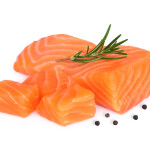Prices on fresh seafood – particularly shellfish – and shelf-stable seafood continued to drop in November, but sales and volumes declined in all segments, according to data from research firm Circana.
Fresh seafood prices declined 2.4 percent in November, according to Circana OmniMarket Integrated Fresh and 210 Analytics. Shellfish prices dropped 10.3 percent on average, with fresh crab prices falling 19.9 percent in November and fresh shrimp prices dropping 11 percent. Fresh catfish prices fell 4.3 percent.
“Prices came down across the board in comparison with November 2022, with the one exception of fresh finfish,” Roerink told SeafoodSource.
Not all seafood categories declined in prices. Fresh finfish prices rose 2.7 percent, lobster prices jumped 7.2 percent, and fresh salmon prices rose 5.1 percent. Overall, the cost of seafood remained elevated compared to other proteins, according to Roerink. In November, the average price of chicken was USD 2.99 (EUR 2.79) per pound, while pork’s average price was USD 3.21 (EUR 2.98) per pound and beef was USD 6.44 (EUR 5.98) a pound, Roerink said.
“At an average price per pound of USD 9.19 [EUR 8.53], prices [for fresh seafood] are significantly higher than those of the three biggest animal proteins,” she said.
Frozen seafood prices declined by 1.3 percent in the month, largely as a result in declines in top-selling items. Frozen shrimp prices fell 7.3 percent, and frozen salmon prices decreased 7.8 percent. However, over the past three years, salmon prices “still reflected substantial inflation,” Roerink said, with its price up 39.3 percent.
Fresh seafood sales fell 5.7 percent to USD 417 million (EUR 387 million) and sales volume dropped 7 percent for the month ending 26 November compared to November 2022. For the 52 weeks ending November 2023, the fresh seafood category has generated USD 6.3 billion (EUR 5.8 billion), down 3.4 percent, according to Circana.
Frozen seafood sales plunged 10.9 percent to USD 445 million (EUR 413 million) in November, while volume dropped 9.7 percent.
The average price of ambient seafood rose 1.7 percent to USD 2.60 (EUR 2.41) per unit on average in November, but sales of ambient seafood fell 3 percent to USD 183 million (EUR 169.8 million) by value and 4.7 percent by volume.
Similar to October, sardines realized the greatest sales gain, rising 8.9 percent, while ambient salmon sales fell 7.1 percent, and tuna sales dropped 3.4 percent.
In fresh seafood, salmon generated three times the sales of crab, at USD 181 million (EUR 168 million) versus USD 64.6 million (EUR 60 million). Salmon and crab were the top-selling species at retail in the U.S. in November. However, salmon sales remained below last year’s levels, dropping 4.9 percent by value and 9.4 percent by volume.
“Given the [market share] of salmon, it has a large impact on the total fresh seafood performance,” Roerink said.
Crab and cod were the only fresh seafood species that …
Photo courtesy of Trong Nguyen/Shutterstock








